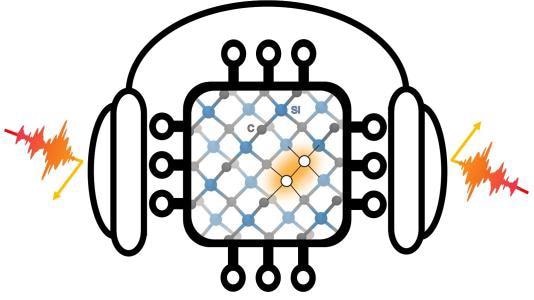Quantum computers have the potential to change research by enabling previously unthinkable computations. However, there is still a long way to go and several difficult tests to pass before quantum computers become mainstream.
 Promising spin qubits for quantum technologies, such as defects in silicon carbide, are simulated on a quantum computer, revealing and mitigating the effect of hardware noise. Image Credit: Benchen Huang, University of Chicago
Promising spin qubits for quantum technologies, such as defects in silicon carbide, are simulated on a quantum computer, revealing and mitigating the effect of hardware noise. Image Credit: Benchen Huang, University of Chicago
One of the tests involves simulating the properties of materials for next-generation quantum technologies utilizing quantum computers.
Scientists from the U.S. Department of Energy’s (DOE) Argonne National Laboratory and the University of Chicago conducted quantum simulations of spin flaws - unique imperfections in materials that could provide a viable foundation for new quantum technologies. By accounting for noise caused by quantum hardware, the study enhanced the precision of calculations on quantum computers.
We want to learn how to use new computational technologies that are up-and-coming. Developing robust strategies in the early days of quantum computing is an important first step in being able to understand how to use these machines efficiently in the future.
Giulia Galli, Study Lead Author and Professor, Pritzker School of Molecular Engineering, University of Chicago
The study was carried out as part of the Midwest Integrated Center for Computational Materials (MICCoM), a DOE computational materials science program based at Argonne National Laboratory, and Q-NEXT, a DOE National Quantum Information Science Research Center.
The reasons we do these kinds of simulations is to gain a fundamental understanding of materials properties and also to tell experimentalists how to eventually better design materials for new technologies.
Giulia Galli, Study Lead Author and Professor, Pritzker School of Molecular Engineering, University of Chicago
Galli was also a professor at the Department of Chemistry at the University of Chicago, senior scientist at Argonne National Laboratory, and Q-NEXT collaborator and director of MICCoM.
“Experimental results obtained for quantum systems are often rather intricate and may be hard to interpret. Having a simulation is important to help interpret experimental results and then put forward new predictions,” Galli added.
While ordinary computers have long been used to run quantum simulations, quantum computers may be able to fix things that even the most powerful modern computers cannot. Reaching that target remains to be seen, as researchers across the globe continue the effort to build and use quantum computers
We want to learn how to use new computational technologies that are up-and-coming. Developing robust strategies in the early days of quantum computing is an important first step in being able to understand how to use these machines efficiently in the future.
Giulia Galli, Study Lead Author and Professor, Pritzker School of Molecular Engineering, University of Chicago
Examining spin defects provides a practical way to test quantum computing capabilities.
“The great majority of calculations with quantum computers these days are on model systems. These models are interesting in theory, but simulating an actual material of experimental interest is more valuable to the whole scientific community,” Galli said.
When using quantum computers to calculate the properties of materials and molecules, an issue known as hardware noise arises, which is not present in traditional computers.
Every time a calculation is conducted, noisy calculations provide slightly different results—for example, a noisy addition operation can yield values subtly different from 4 for the question “What is 2 plus 2?”
The uncertainty in the measurement depends on the quantum hardware. One of the accomplishments of our work is that we were able to correct our simulations to compensate for the noise that we encountered on the hardware.
Marco Govoni, Study Co-Lead Author and Scientist, Argonne National Laboratory
The primary author of the work, graduate student Benchen Huang from the University of Chicago, said that learning how to manage noise in quantum computers for live simulations is an essential accomplishment.
“We can anticipate that in the future we might have noiseless quantum computing — learning how to eliminate or cancel the noise in our simulation will also teach us whether quantum advantage may become a reality and for which problems in materials science,” Galli added.
In the end, Galli believes that quantum computers’ revolutionary potential will encourage greater research in this area.
“We’ve just started,” she said. “The road ahead looks full of exciting challenges.”
Journal Reference:
Huang, B., et al. (2022) Simulating the Electronic Structure of Spin Defects on Quantum Computers. Physical Review X Quantum. doi.org/10.1103/PRXQuantum.3.010339.